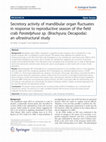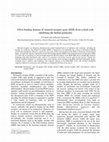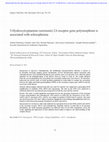Papers by Anilkumar Gopinathan

Journal of biotechnology & biomaterials, Dec 10, 2015
N on-peptide hormones (like steroids) rely on Nuclear Receptors (NRs) to activate the target gene... more N on-peptide hormones (like steroids) rely on Nuclear Receptors (NRs) to activate the target gene to effect hormone action. To bind with the hormone (ligand), NR has ligand binding domain (LBD). The other domain which is functionally important is the DNA binding domain (DBD), a highly conserved domain, instrumental in binding with the target gene. Evidently, NRs are ubiquitous among metazoans in both vertebrates and invertebrates. The ecdysteroids act as hormones that promote growth in several invertebrates and are known to act through the NR, theecdysteroid receptor (EcR), encoded by the ecdysteroid receptor gene (EcR). EcR expression is found to fluctuate in a stage-dependant manner related to growth. Insects became the first model organism wherein the EcR was detected and the expression was studied. Subsequently, EcR was detected in other invertebrate groups as well. Crustaceans became the other major group wherein the EcR gene expression was studied. Interestingly, Carney and Bender (2000) have demonstrated that ecdysteroid receptor is a requisite for successful vitellogenesis in Drosophila. Since then, researchers have been trying to unravel the role of EcR in insect reproduction. Investigations have also led to the identification of retinoid receptors that dimerize with the EcR to accomplish the hormone action. These results have encouraged the carcinologists to hypothesize that a comparable situation might exist in crustaceans as well. Of late, the experiments performed on Drosophila and Tribolium have shown a putative receptor (the 'Met' receptor) for the terpenoid hormone (JH), analog of MF, the gonadotropic hormone in crustaceans. However, the exact mechanism of the cascade of events, beginning from the ecdysteroids, leading to vitellogenesis is yet to be understood. The present paper would discuss at length, the possibilities of these hormone receptors getting involved in growth and reproduction in invertebrates.

International journal of scientific research, 2017
Nuclear receptors (NRs), comprising a distinct ‘cohort’ of (protein) molecules, belonging to th... more Nuclear receptors (NRs), comprising a distinct ‘cohort’ of (protein) molecules, belonging to the Nuclear Receptor superfamily, are suggested to play key role in mediating between the hormone molecule and the target tissue. NRs are known to bind with smaller molecules – the ligands -such as steroids, retinoids, vitamins, terpenoids and farnesol metabolites; the hormone-receptor complex, then moves towards the hormone response element (HRE) situated in the target gene, to effect hormone action. However, notwithstanding the considerable literature available with respect to vertebrates, our understanding on the exact role of receptor proteins in signalling and eliciting the response at molecular level is too fragmentary in invertebrates (excepting perhaps in insects). Significantly, invertebrates in general are suggested to rely on NR for eliciting the hormone response. However, we have only scanty information on the exact mechanism involved in hormone action with respect to non-ins...

Functional domains of nuclear receptor superfamily, 2021
The major functional domains (DNA binding domain, DBD and ligand-binding domain, LBD) of the ecdy... more The major functional domains (DNA binding domain, DBD and ligand-binding domain, LBD) of the ecdysteroid receptor gene (EcR), of the field crab (Parathelphusa hydrodromous) inhabiting the Indian peninsula are being elucidated in this paper. Oligo (dT) primed cDNA synthesis, PCR amplification and multiple sequence alignment (MSA) revealed that PhEcRDBD comprises 189 bp, showing 100% identity in amino acid sequence with those of all the six brachyuran crabs studied to date. PhEcRLBD (654 bp) has shown ~90-99% identity with Gecarcinucid/Parathelphusid field crabs; with other brachyurans and non-brachyurans, the identity declined perceptibly (~73-90%). Compared to PhEcRDBD, PhEcRLBD is less conserved, apparently due to its multiple functions such as homo/hetero dimerization and transcriptional activation/repression, in addition to ligand binding. MSA could locate non-synonymous substitutions, signifying differences in amino acid content existing among various taxa; this difference, however, does not seem to affect the efficacy of the ligand binding, evidenced by in silico docking studies. Interestingly, in addition to providing us with basic information on ecdysteroid receptors, the present MSA and phylogenetic analysis implicate the existence of parallelism between LBD sequence diversity and the habitat of the animal in question, in the order of-Gecarcinucid/Parathelphusid (field) crabs, non-Gecarcinucid/Parathelphusid (estuarine/marine crabs), non-brachyurans and non-crustacean arthropods, respectively.

Zoological Studies, 2014
Background Mandibular organ (MO) in decapods is suggested to play regulatory role in reproduction... more Background Mandibular organ (MO) in decapods is suggested to play regulatory role in reproduction, in few species; however, MO is considered to control growth. The present study addresses this question by an ultrastructural study on the MO of the field crab, Paratelphusa sp. Our sampling for consecutive years (2008 to 2012) revealed that Paratelphusa sp. devotes July to October for reproduction, judged by the occurrence of growing ovaries and the berried females. From November to the succeeding June, the females are in a state of reproductive arrest (non-reproductive period); ovaries during this season would appear as white bands with no signs of yolk deposition. Results Morphologically, MO of Paratelphusa sp. is positioned posterior to the mandibles and is in close apposition with the distal end of the mandibular apodeme. MO of Paratelphusa sp. exhibited significant levels (t = 8.097, P
<p>Map showing sample locations in the high background radiation area (HBRA) Chavara, Puthe... more <p>Map showing sample locations in the high background radiation area (HBRA) Chavara, Puthenthura and Neendakara in Kollam District, Kerala, India.</p
Survey on cymothoids infesting the marine fishes from the Malabar Coast, India recorded two speci... more Survey on cymothoids infesting the marine fishes from the Malabar Coast, India recorded two species (Glossobius auritus Bovallius 1885 and Glossobius hemiramphi Williams and Williams 1985), new to India and both appear with new host fish, Cypselurus oligolepis (Bleeker) for G. auritus and Hemiramphus lutkei (Valencinnes) for G. hemiramphi. In the present paper, both species are re-described based on the live and fresh specimens collected from India; Re-description of G. auritus is based on male and female stages, while all the available life cycle stages such as male, transitional, female, juvenile and larvae (manca and premanca) were considered for the re-description of G. hemiramphi. The occurrence, distribution, site specific infestation and fecundity of newly recorded Glossobius spp. are also discussed.

Acta Oceanologica Sinica, 2019
Pennellid copepod Peniculus fistula fistula (Nordmann, 1832) (Synonym: Peniculus fistula Nordmann... more Pennellid copepod Peniculus fistula fistula (Nordmann, 1832) (Synonym: Peniculus fistula Nordmann, 1832, Aphia ID: 745880), a worldwide distributed species, has been recovered from at least 19 teleost families. The present paper reports for the first time from the Malabar coast (South India), not only the existence of a new host family, Clupeidae, hosting this parasitic copepod species (P. fistula fistula) but also their season dependent hosting. A total of 123 marine fish species, belonging to 77 genera and 38 families surveyed along the Malabar coast, only the clupeid, Anadontostoma chacunda (Hamilton, 1822) was shown to be infected by this copepod species; all the recovered (copepod) parasites were invariably found attached at the mid portion of the caudal fin lobes and lying parallel to the host body, indicating the strict site-specific parasitisation. There is a discrete seasonality in the prevalence (P<0.05) as the sign of infection was noticed during the period from September to May with relatively high prevalence during winter months (November-January). During the monsoon months (June-August), the host fish was found completely free from Peniculus infection. Interestingly, all the 229 recovered specimens (P. fistula fistula) were gravid females having paired uniserrate egg sacs with the length more than its own body length.

Aquaculture International, 2016
The paper defines the methods for maintenance of maximum density (Nmax) in respect of the freshwa... more The paper defines the methods for maintenance of maximum density (Nmax) in respect of the freshwater crayfish (Astacus leptodactylus) fingerlings (larvae/juveniles), a prospective model organism for aquaculture. The question of optimal maintenance of the fingerlings has been addressed in the present study, considering the following parameters: (1) the ratio between the total area on which the fingerlings are being grown, and the area occupied by one individual, and (2) the planting density dependence on the specific growth rate of differently aged individuals (Cw). Analysis of our results shows that the Nmax values decrease significantly with the growth of individuals (4167, 2222 and 617 ind. m−2 for 30, 65 and 120 days old fingerlings, respectively). The values of Cw for individuals at the age of 30 days, however, do not depend on rearing density within the range of 300–1500 ind. m−2. A linear decrease in Cw is observed in density gradient for older ages. The density at which Cw becomes equal to zero is 3553 ind. m−2 for 65 days old fingerlings, and 1307 ind. m−2 for the 120 days old ones. The revealed differences (with respect to growth rates and planting densities in different age groups) may presumably be caused by the influence of the specific mechanisms of an intra-populational regulation, tenable with the conditions of high densities of fingerlings.
General and Comparative Endocrinology, 2015

Context: Melioidosis and Brucellosis are important endemic infections among people in India, espe... more Context: Melioidosis and Brucellosis are important endemic infections among people in India, especially in rural settings. Conventional detection techniques have several limitations. Only a few studies exist on the prevalence of Melioidosis and Brucellosis in rural area especially in India. Aim: We sought to evaluate detection of Burkholderia pseudomallei and Brucella spp. among patients presenting febrile illness. Material and Methods: Previously described polymerase chain reaction (PCR) assays for both pathogens were evaluated with Deoxyribonucleic acid extracts of buffy coat samples collected from 301 patients recruited prospectively. Data was not amenable to statistical analysis. Results: The PCR showed specific amplification and no non-specific amplification with heterologous Gram-negative bacilli. The lower limit of detection of the assay for B. pseudomallei was determined to be 1 colony-forming unit /mL and for Brucella it was 1.95 × 103 plasmids per microliter. Blood culture...

Retinoid receptors are ubiquitous throughout the animal kingdom both in invertebrates and vertebr... more Retinoid receptors are ubiquitous throughout the animal kingdom both in invertebrates and vertebrates, including the humans. In vertebrates, the retinoid X receptor (RXR) is suggested to be responsible for a variety of functions including growth and reproduction. However, reports are very scarce on the exact function of the RXR in crustaceans. In the present paper, we report the sequence information on the DNA binding domain (DBD) of the retinoid hormone receptor gene (RXR) of a field crab, Paratelphusa sp. from the Indian peninsula. BLAST analysis of the RXR-DBD shows considerable sequence homology with other brachyuran crabs, such as, Uca pugilator, Gecarcinus lateralis and Carcinus maenas. Taking cues from the GenBank database, we could also draw out the identity of this domain of the RXR with major phylogenic groups, including insects, molluscs and vertebrates. The sequence analysis of the RXR-DBD of the crab revealed remarkable sequence similarity to crustaceans and vertebrates...

Systematic Parasitology, 2016
Mothocya renardi (Bleeker, 1857), a protandrically hermaphroditic cymothoid, parasitising the ban... more Mothocya renardi (Bleeker, 1857), a protandrically hermaphroditic cymothoid, parasitising the banded needle fish Strongylura leiura (Bleeker) from the Malabar Coast, India is redescribed and morphological data for different life-cycle stages [male, transitional and ovigerous female, larvae (pre-manca and manca) and juvenile] are provided. Mothocya renardi exhibited strict oligoxenous host specificity by infesting only S. leiura and showed high prevalence levels (reaching up to 92%). The life-cycle of M. renardi comprises three major phases (marsupial phase, free living phase and infestive phase). The marsupial phase comprised one zygotic, three embryonic and two larval stages, all of which remained in the marsupium until the final staged manca is released into the surrounding water. After having led a short free- swimming life, the manca infested the branchial cavity of the host fish, S. leiura. Subsequently it was transformed successively into juvenile, male, transitional and finally functional female through biphasic moult which occurs in between each stage. Based on the presence (or absence) of a brood pouch and/or marsupiumites, six successive stages of the female population were also identified. These data will help precise identification of the female M. renardi irrespective of their stage. The present paper also discusses the host-parasite interactions between S. leiura and M. renardi.

More than half a century of chemical communication research has served a key role in promoting aw... more More than half a century of chemical communication research has served a key role in promoting awareness and expansion of knowledge in theoretical and applied problems in organismal biology. Tristram Wyatt's Pheromones and Animal Behaviour is an accessible textbook that offers advanced undergraduate and graduate students a data-based, integrative, and broadly comparative synthesis of this field. Crossing back and forth between invertebrate-vertebrate boundaries more freely than any other text in this area, Wyatt grounds behavioral, ecological, and biochemical observations of pheromonal communication in an evolutionary context. A broadly recognized caveat to workers in this field, derived from the primary literature and in this and other texts, is the willing acceptance and repetition of Ôjust soÕ evolutionary stories from researchers who contend to have identified absolute functions of pheromonal communication.

The Indian Journal of Medical Research, Dec 1, 2014
Background & objectives: Schizophrenia, the debilitating neuropsychiatric disorder, is known to b... more Background & objectives: Schizophrenia, the debilitating neuropsychiatric disorder, is known to be heritable, involving complex genetic mechanisms. Several chromosomal regions associated with schizophrenia have been identified during the past; putative gene (s) in question, to be called the global signature for the pathophysiology of the disease, however, seems to evade us. The results obtained from the several population-wise association-non association studies have been diverse. w0 e therefore, undertook the present study on Tamil speaking population in south India to examine the association between the single nucleotide polymorphisms (SNPs) at the serotonin receptor gene (5HT2A) and the occurrence of the disease. Methods: Blood samples collected from 266 cases and 272 controls were subjected to genotyping (PCR amplification of candidate SNPs, RFLP and sequencing). The data on the SNPs were subjected to statistical analysis for assessing the gene frequencies in both the cases and the controls. Results: The study revealed significant association between the genotypic frequencies of the serotonin receptor polymorphism and schizophrenia. SNP analysis revealed that the frequencies of GG (30%, rs6311) and CC genotypes (32%, rs6313), were higher in patients (P<0.05) than in controls. The study also showed presence of G and C alleles in patients. s0 ignificant levels of linkage disequilibrium (LD) were found to exist between the genotype frequencies of rs6311 and rs6313. Interpretation & conclusions: This study indicated an association between the SNPs (rs6311 and rs6313) of the serotonin receptor 5HT2A and schizophrenia. HapMap analysis revealed that in its genotype distribution, the Tamil speaking population was different from several other populations across the world, signifying the importance of such ethnicity-based studies to improve our understanding of this complex disease.

Zoological studies
Hemolymph ecdysteroid titers in a brachyuran crab Uca triangularis that concomitantly undergoes m... more Hemolymph ecdysteroid titers in a brachyuran crab Uca triangularis that concomitantly undergoes molting and reproduction. Zoological Studies 51(7): 966-976. Investigations conducted thus far suggest that premolt growth and ovarian growth are antagonistic events in brachyuran crabs, arguably implying that yolk deposition does not occur during premolt when the ecdysteroid titer is very high. The present paper examines ecdysteroid levels in a brachyuran crab Uca triangularis that exhibits simultaneous programming of premolt growth and reproduction during certain seasons of the year. The species exhibits 2 patterns of breeding cycles, 1 (premolt breeding cycle) synchronous with the premolt cycle during Feb.-May, and the other (intermolt breeding cycle) taking place only during intermolt (Aug.-Jan.); no breeding activity occurs during June-July. Results depicted in the present paper are also expected to help us evaluate the possible role of ecdysteroids in reproduction in crustaceans, a ...
Zoological Studies, 2015
Background: Cymothoa frontalis Milne Edward, 1840 is a very poorly described cymothoid, notwithst... more Background: Cymothoa frontalis Milne Edward, 1840 is a very poorly described cymothoid, notwithstanding the previous redescription of the female. Pertinently, to date, the host of C. frontalis has not been identified with adequate precision. Most of the descriptions of cymothoids carried out hitherto were based primarily on females, but practically ignoring other life cycle stages. The present paper redescribes the female and describes other life cycle stages of the species C. frontalis to get better precision in their identification.

The Indian journal of medical research, 2014
Schizophrenia, the debilitating neuropsychiatric disorder, is known to be heritable, involving co... more Schizophrenia, the debilitating neuropsychiatric disorder, is known to be heritable, involving complex genetic mechanisms. Several chromosomal regions associated with schizophrenia have been identified during the past; putative gene (s) in question, to be called the global signature for the pathophysiology of the disease, however, seems to evade us. The results obtained from the several population-wise association-non association studies have been diverse. w0 e therefore, undertook the present study on Tamil speaking population in south India to examine the association between the single nucleotide polymorphisms (SNPs) at the serotonin receptor gene (5HT2A) and the occurrence of the disease. Blood samples collected from 266 cases and 272 controls were subjected to genotyping (PCR amplification of candidate SNPs, RFLP and sequencing). The data on the SNPs were subjected to statistical analysis for assessing the gene frequencies in both the cases and the controls. The study revealed s...

Uploads
Papers by Anilkumar Gopinathan